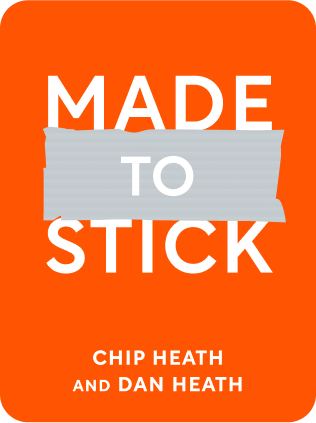

This article is an excerpt from the Shortform book guide to "Made to Stick" by Chip Heath and Dan Heath. Shortform has the world's best summaries and analyses of books you should be reading.
Like this article? Sign up for a free trial here .
Have you read Made to Stick: Why Some Ideas Survive and Others Die? What are the key takeaways?
In our hyper-connected society, important messages often fail to gain traction, while bad ideas and falsehoods go viral and seem to stick around forever. Made to Stick: Why Some Ideas Survive and Others Die explores what makes some messages “stick”. Based on a wide-ranging research, the book identifies six criteria that anyone can apply for shaping a sticky message.
Continue reading for key takeaways of Made to Stick: Why Some Ideas Survive and Others Die.
Made to Stick: Why Some Ideas Survive and Others Die
In our overstimulated and distracted society, great ideas and important messages often fail to gain traction, while bad ideas and falsehoods such as urban legends go viral and seem to stick around forever.
Made to Stick: Why Some Ideas Survive and Others Die by brothers Chip and Dan Heath explores what makes some messages “stick” in the public’s consciousness while others go unheard or unremembered and explains how to create an idea that sticks. Chip is a professor at Stanford, and Dan is senior fellow at Duke University. Based on a wide-ranging examination of psychology research, popular culture, and news headlines, they identify six criteria for shaping your message so it resonates.
You don’t have to be a great speaker or be particularly creative to communicate effectively. Rather than sweating over an original presentation, you can emulate someone else’s idea that worked or follow the “stickiness” template provided in Made to Stick: Why Some Ideas Survive and Others Die.
Shaping Ideas
We all have messages and ideas we need to deliver, but often struggle to get them across. For instance:
- Teachers must explain mitosis or introduce algebra so it’s understandable.
- Managers have to get employees to implement new company initiatives.
- Directors of charities need to present their missions in a way that makes people care about them and donate.
- Political candidates want to communicate their policy ideas to voters.
With all of the messages, especially false ones, competing for people’s attention, getting necessary messages across is daunting. Yet even an idea less riveting than the kidney heist story can be designed in a way that makes it memorable.
For example, in 1992, the Center for Science in the Public Interest, a nonprofit group that educates the public on nutrition, analyzed the ingredients of movie theater popcorn. Its testing showed that a medium-sized serving of popcorn had 37 grams of saturated fat, compared to the USDA’s recommendation that people consume no more than 20 grams a day. At the time, movie popcorn typically was made with coconut oil, which had advantages over other oils but was also higher in saturated fat. CSPI’s challenge was to put the numbers into some kind of meaningful context and present them in a memorable way. They had to make the message—movie popcorn is very unhealthy—stick.
The organization called a press conference at which they displayed a medium serving of movie popcorn juxtaposed with three meals: a bacon-and-eggs breakfast, a Big Mac-and-fries lunch, and a complete steak dinner. The message: One serving of movie popcorn has more saturated fat than a full day’s worth of high-fat meals. The story caught the attention of the major television networks and newspapers as well as late-night comedians. As a result, moviegoers shunned popcorn until the biggest theater chains announced they would stop using coconut oil.
CSPI had an important message to share, they came up with a way to communicate it so that people would hear and care about it, and the message resonated or stuck. They did it despite lacking a sensational topic, a multimillion-dollar budget, or a staff of professional marketers. You can craft equally effective messages.
Six Principles of Made to Stick: Why Some Ideas Survive and Others Die
1) Simple
Making a message simple means distilling it to its central point or essence by cutting away nonessential information, like getting to the core of an apple. In addition to being simple, a distilled message must be meaningful. Proverbs are a good example of simple, profound messages, as is the Golden Rule.
Tips:
- Focus on one thing. Don’t include multiple things in your message. For example, Southwest’s message is focused on the single idea that it’s “the low-fare airline.”
- Communicate your key point in memorable terms. For example, Bill Clinton was elected on his slogan, “It’s the Economy, Stupid.” The last word made it memorable.
2) Unexpected
A sticky message gets people’s attention by defying expectations. For example, an airline flight attendant got passengers’ attention with her flight safety lecture by turning it into a comedy routine: “As the song goes, there might be fifty ways to leave your lover, but there are only six ways to leave this aircraft.”
Tips:
- Avoid the gimmicky surprise. Gimmicks that aren’t relevant to your core message leave your listeners feeling puzzled or cheated.
- After getting people’s attention with the unexpected, sustain it by creating a mystery. Mysteries sustain interest because people want closure.
3) Concrete
Ideas must be concrete in order to stick. For example, the idea of apples with razor blades in them is concrete. In contrast, many messages in business are ambiguous and no one interprets them the same way. The abstract must be made concrete so that it means the same thing to everyone, like the proverb, “A bird in the hand is worth two in the bush.”
Tip:
- Be specific: The words “high performance” are abstract while “V-8 engine” is concrete. A company’s strategy is abstract, but its software is concrete. Find ways to make abstract concepts more concrete.
4) Credible
To be believable, sticky ideas must have external credibility (an authoritative spokesperson or source) and internal credibility, which means they’re supported by details, data, or a compelling example that clinches the argument. For example, a series of anti-smoking ads in the 1990s was credible because the ads had an authoritative spokeswoman: Pam Laffin, a 29-year-old mother who suffered devastating effects from smoking.
Tips:
- Concrete, vivid details make a message believable. For instance, urban legends, particularly horror stories, seem credible when localized details, such as street names and familiar landmarks, are used.
- One standout example can be your ultimate credential. For instance, if your company provided security for Fort Knox, that fact alone would say more about the value of your security services than any numbers you could quote.
5) Emotional
To get an idea to stick, you need to get people to care about it. To make them care, you arouse emotions—you make them feel. The Halloween candy tampering message generated fear. Nonprofit organizations seeking donations generate emotions by showing you people—here’s a starving child named Rokia—rather than presenting abstractions such as statistics. The trick is determining what emotion you want to generate.
Tips:
- Appeal to their self-interest: tell them how they personally will benefit from acting on your message. Advertising offers many examples.
- Appeal to group identity, which can take precedence at times over self-interest. Group affiliations include religion, political party, gender, and occupation.
6) Stories
Telling stories is the best way to make a message memorable and get people to act on it. Stories motivate people to act through inspiration. But more importantly, they tell people how to act—stories are simulations in which listeners think through what they’d do in the same situation. They’re mental flight simulators. For instance, firefighters and medical personnel can learn how to respond to crises from the stories of colleagues.
Tip:
- The best inspirational stories follow one of three common plots: 1) challenge—people overcome obstacles, 2) connection—people develop relationships across gaps, or 3) creativity—people solve problems and inspire new ways of thinking.
Practical Challenges
Made to Stick: Why Some Ideas Survive and Others Die includes a SUCCESs checklist. Following are some challenges and tips for putting the checklist into practice to make your ideas stick.
1) If the message works, leave it alone, even if it’s not exactly the message you intended. Once you’ve presented your idea, your audience owns it and may adapt it in ways you didn’t expect. They may change the meaning, compress it, or improve on it. For instance, Dodgers coach Leo Durocher is credited with the phrase, “Nice guys finish last,” but he actually said something longer and more complicated. For years, he denied the shortened version, but it stuck and he eventually gave up and used it as the title of his autobiography.
2) To stay alert and able to spot useful ideas and stories, imagine wearing a set of core idea lenses, allowing you to look at things from the perspective of how they might support your core idea. This is similar to the way you start keeping an eye out for an appropriate gift when you know someone’s birthday is coming up.
3) Don’t worry about being a great speaker—worry instead about telling the right story. A Stanford study showed that even when you have strong speaking skills, people don’t remember what you say, especially data, unless you make it sticky by telling a good story. Also beware of the curse of knowledge—communicate at the level of your audience.
4) Use the SUCCESs checklist to address these problems:
- They’re not listening. Surprise them or create a mystery or puzzle that arouses curiosity and holds their attention.
- They’re not getting it. Simplify your message and be concrete. Use a generative analogy or tell a story.
- They’re skeptical. Build credibility with relevant details. Use someone who can speak from experience.
- No one seems to care. Tell a challenge story or a creativity story. Appeal to group identity.
5) Remember that with sticky ideas, you can make a difference. Think of Jane Elliott’s lesson on prejudice, Floyd Lee’s mess hall, Barry Marshall’s ulcer demonstration, Nora Ephron’s journalism teacher. Normal people in everyday situations, who know how to make ideas stick, have a profound impact.
Made to Stick: Why Some Ideas Survive and Others Die is a practical guide for anyone who wants to make their message heard.

———End of Preview———
Like what you just read? Read the rest of the world's best book summary and analysis of Chip Heath and Dan Heath's "Made to Stick" at Shortform .
Here's what you'll find in our full Made to Stick summary :
- What makes some messages “stick” while others go unremembered
- The six criteria for shaping your message so it resonates
- Why many companies are blinded by “the curse of knowledge”






